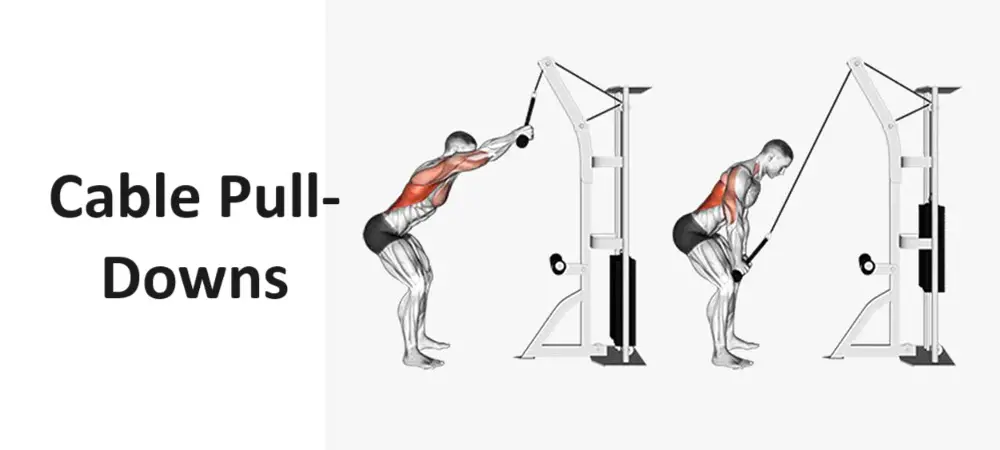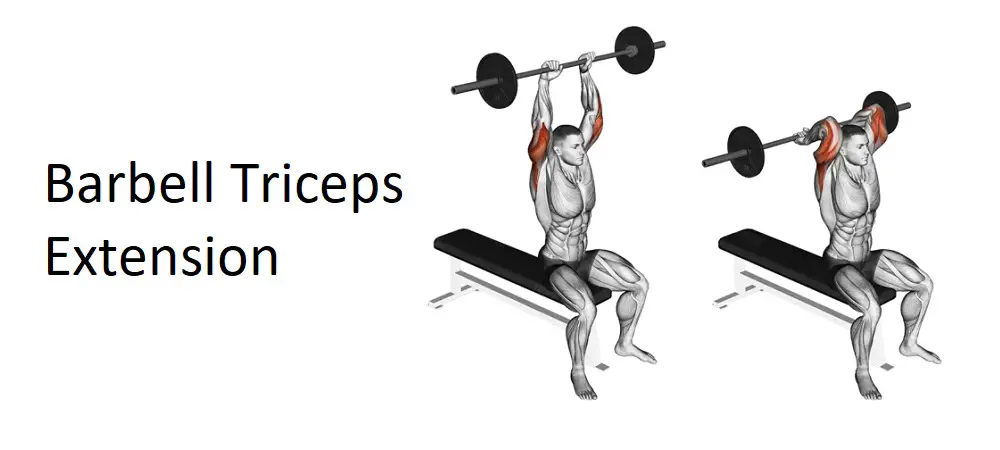Table of Contents
Introduction
Cable Pull-Downs are a popular strength training exercise that primarily targets the muscles of the back, specifically the latissimus dorsi (lats). This compound movement is commonly performed using a cable machine and is effective for building upper body strength and muscle definition. In this comprehensive guide, we’ll explore the correct technique, benefits, variations, and other essential details associated with Cable Pull-Downs.
Instructions
Setup:
- Machine Adjustment: Set up the cable machine with a wide grip attachment. Adjust the weight stack to a suitable resistance level.
- Seating Position: Sit on the pull-down machine with your knees secured under the pads. Ensure that your thighs are snugly positioned against the pads, and your feet are flat on the ground.
Execution:
- Grip: Grasp the wide grip attachment with an overhand grip (palms facing away from you) slightly wider than shoulder-width apart. Your arms should be fully extended overhead.
- Pulling Motion: Exhale as you pull the bar down towards your chest in a smooth and controlled manner, driving your elbows downwards and backwards. Focus on engaging your lats throughout the movement.
- Peak Contraction: Once the bar is pulled down as far as comfortably possible, pause briefly and squeeze your back muscles to maximize the contraction.
- Return to Starting Position: Inhale as you slowly allow the bar to return to the starting position, maintaining control over the movement. Avoid letting the weight stack slam or bounce back up.
- Repeat: Perform the desired number of repetitions, ensuring proper form and maintaining tension on the muscles throughout the set.
Benefits
- Muscle Development: Cable Pull-Downs primarily target the latissimus dorsi, which is the largest muscle in the back. Strengthening the lats contributes to improved back width, thickness, and overall muscle definition.
- Compound Movement: As a compound exercise, Cable Pull-Downs engage multiple muscle groups simultaneously, including the rhomboids, traps, rear deltoids, and biceps. This makes it an efficient choice for building upper body strength and muscle mass.
- Joint Stability: Performing Cable Pull-Downs helps improve shoulder joint stability and mobility by strengthening the muscles surrounding the shoulder girdle.
- Versatility: Cable Pull-Downs offer a wide range of grip variations, allowing you to target different areas of the back and adapt the exercise to your individual preferences and goals.
Muscles worked in Cable Pull-Downs
Cable Pull-Downs primarily target the latissimus dorsi (lats), which are the large muscles that run down the sides of the back. Additionally, several other muscles are engaged as synergists or stabilizers during the exercise. The key muscles worked during Cable Pull-Downs include:
- Latissimus Dorsi (Lats): The primary muscle targeted by Cable Pull-Downs, the lats are responsible for the extension, adduction, and internal rotation of the shoulder joint. Strengthening the lats contributes to improved back width, thickness, and overall muscle definition.
- Trapezius (Traps): The traps, particularly the upper fibers, are engaged to stabilize the shoulders and scapulae during the downward pulling motion. They help maintain proper posture and shoulder alignment throughout the exercise.
- Rhomboids: Located between the shoulder blades, the rhomboids assist in scapular retraction and stabilization. They work synergistically with the lats to pull the shoulder blades down and back during the pulling motion.
- Posterior Deltoids: The rear deltoids, situated at the back of the shoulders, assist in shoulder extension and stabilization during Cable Pull-Downs. They help control the movement of the arms as they are pulled down towards the body.
- Biceps Brachii: While not the primary target, the biceps brachii act as dynamic stabilizers during Cable Pull-Downs. They assist in elbow flexion as the bar is pulled down towards the body.
- Forearm Muscles: The muscles of the forearms, including the brachioradialis and forearm flexors, are engaged to grip and hold onto the cable attachment securely throughout the exercise.
By targeting these muscles, Cable Pull-Downs effectively strengthen and develop the muscles of the back, shoulders, and arms. It’s important to maintain proper form and technique to effectively engage these muscles and minimize the risk of injury. If you experience any discomfort or pain during the exercise, cease immediately and consult with a fitness professional or healthcare provider.
Variations
- Underhand Grip Pull-Downs: Perform the exercise with an underhand grip (palms facing towards you) to emphasize the lower lats and biceps.
- Single-Arm Pull-Downs: Perform the exercise one arm at a time to address any muscular imbalances and engage the core for stabilization.
- Wide Grip vs. Narrow Grip: Experiment with different grip widths to target different areas of the back and vary the intensity of the exercise.
Alternate names for Cable Pull-Downs
- Cable Lat Pull-Downs
- Cable Lat Pulldowns
- Cable Lat Pulls
- Cable Lat Pulling Exercises
FAQs
What are Cable Pull-Downs?
Cable pull-downs are a strength training exercise that primarily targets the muscles of the upper back, particularly the latissimus dorsi (“lats”). This exercise involves pulling a cable attachment downward towards your body against resistance.
How do I perform Cable Pull-Downs?
Sit down on a cable pull-down machine with your knees secured under the pads. Grasp the cable attachment (usually a wide bar or handles) with an overhand grip, hands slightly wider than shoulder-width apart.
Pull the attachment downward towards your chest by driving your elbows down and back, engaging your lat muscles. Keep your chest up, shoulders down, and back straight throughout the movement.
Pause briefly when the attachment reaches your chest, then slowly release it back to the starting position, allowing your arms to fully extend.
Repeat for the desired number of repetitions.
Which muscles do Cable Pull-Downs target?
Cable pull-downs primarily target the latissimus dorsi (“lats”), which are the large muscles of the back responsible for shoulder extension and adduction. Additionally, they engage the muscles of the upper back, including the rhomboids, traps, and rear deltoids.
What equipment is needed for Cable Pull-Downs?
You’ll need access to a cable pull-down machine equipped with a high pulley attachment and a suitable handle or bar for gripping. Additionally, you may need a bench or seat to sit on during the exercise.
What are some variations of Cable Pull-Downs?
Variations of cable pull-downs include:
Wide-grip pull-downs: Using a wider grip on the bar to target the outer portion of the lats.
Close-grip pull-downs: Using a narrower grip to emphasize the inner portion of the lats and engage the biceps more.
Reverse grip pull-downs: Holding the bar with an underhand grip to emphasize the lower portion of the lats and engage the biceps more.
How many sets and reps should I do for it?
The number of sets and reps depends on your fitness goals, experience level, and overall workout routine. A typical range might be 3-4 sets of 8-12 repetitions.
Are Cable Pull-Downs suitable for beginners?
Yes, cable pull-downs can be suitable for beginners as long as proper form is maintained. It’s essential to start with a light weight to learn the movement pattern and gradually increase the resistance as you become more comfortable and proficient.
Can it help with building muscle and strength?
Yes, cable pull-downs are an effective exercise for building muscle and strength in the upper back, particularly the lat muscles. They also help improve grip strength and overall pulling power.
Is it normal to feel discomfort during Cable Pull-Downs?
You may experience muscle fatigue or discomfort in the muscles being worked, particularly the lats and upper back. However, you should not feel sharp or shooting pain, especially in the joints. If you do, stop the exercise and reassess your form or seek guidance from a fitness professional.
Are there any safety considerations for it?
It’s essential to use proper form and technique to avoid injury during cable pull-downs. Ensure that your back remains straight, your shoulders are down and back, and you engage your core muscles for stability. Additionally, start with a light weight and gradually increase the resistance as you become stronger. If you have any pre-existing back or shoulder issues, consult with a healthcare professional before performing this exercise.
Conclusion
Incorporating it into your workout routine can help you develop a strong and well-defined back. By mastering the proper technique and progressively overloading the muscles, you can experience significant improvements in back strength, muscle size, and overall upper body performance. Remember to start with a light weight and focus on proper form to avoid injury. If you’re new to weightlifting or have any existing injuries or medical conditions, consult with a fitness professional or healthcare provider before attempting Cable Pull-Downs.
Another few Back Exercise
Also, read more A Comparative Analysis and Technique of the Lat Pull-down
Check our Home Page for the latest posts on exercises, travel, and more








